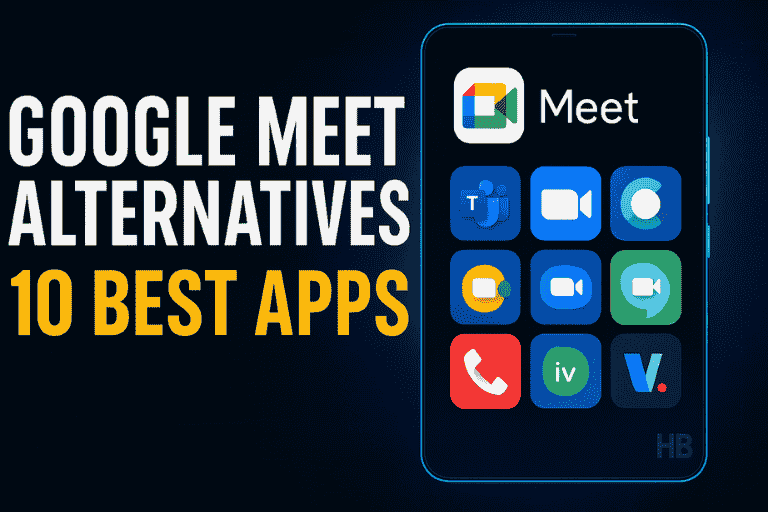Google Meet has proved to be a trustworthy preference for both professional and non-professional meetings however, it is by no means the sole option.
Since remote work, online courses, and hybrid events moved to the center of our daily routine, numerous users seek the available video conferencing tools, which are easy to operate, secure, and flexible.
By 2025, there will be plenty of good platforms in the market, a few representing long-time strong competitors, and some of them brand new and innovative.
Offering a straight alternative to Google Meet is an easy task. These apps are also powerful in terms of video quality, collaboration, and flexible pricing plans, whether you are a student, a professional, or a large stage event hosting organization.
We can go through the 10 best Google Meet alternatives in 2025.
1.Zoom
Zoom is, perhaps, the most famous competitor and is still keeping the video conferencing.
It provides quality video calls, breakout rooms, virtual backgrounds, and strong webinar facilities.
Best for : businesses, schools, and large meetings.
Plans: Free (limit of 40 minutes), Paid Starting at $14.99/Month:
Why select it: Stable, popular, and simple to integrate with other tools.
2.Microsoft Teams
Microsoft Teams is directly built into the integration of video conferencing with Office 365 applications, including Word, Excel, and PowerPoint.
Renowned companies already using Microsoft machinery find Microsoft Teams an extension of the brand name.
Best for: Business cooperation.
Plans : Free version and paid plans containing Microsoft 365.
Why select it: Continuous file transfer, group chat, and excellent integrations at the workplace.
3.Cisco Webex
Webex is known to perform better and provide enterprise level security in corporate environments.
It has capabilities of an AI meeting assistant, noise suppression, and an expansive meeting room.
Best for : government organizations and corporations.
Plans: Free, paying plans starting at $13.50/month.
Why select it: great attention to security and sophisticated team tools.
4. Skype
Not with standing the old age, Skype is still popular with personal users and small businesses.
It favors video conferencing and instant messaging, as well as phone conversations on both landlines and cell phones.
Best for: Out of the pocket and in small teams.
Plans: Free, except phone calls, which are paid with credits.
Why select it: easy interface and high level of accessibility.
5. Slack Huddles & Video
Slack was originally a team messaging platform, though it now has the option of video calls and Huddles to speed up collaboration.
It lacks the features of Zoom or Meet but is useful to have quick check-in team meetings.
Best for: Startups and a small number of businesses that are already using Slack.
Plans: Freemium, paid between $7.25/month.
Why select it: Ideal teams like to chat with a video in-built.
6. Zoho Meeting
One of the emerging competitors, Zoho Meeting, is a no download based and browser-based platform. It facilitates screen sharing, webinar hosting, and recordings hence, it becomes cost-effective.
Best for : small and medium-sized companies.
Plans : Free with basic features,paid between $3/month.
Why select it: Cost-effective, not complex, and safe.
7. BlueJeans by Verizon
BlueJeans is reputed to have HD audio and video as well as Dolby voice use.
Particularly, it is popular when it comes to webinars and virtual events.
Best for: business that is a host of a webinar or online event.
Plans: Free, paid subscriptions starting at $9.99/month.
Why select it: Good sound and stage-centered functions.
8. Jitsi Meet
The open source Jitsi Meet promotes the free unlimited video call that does not necessitate any sign-ups. Also, it can be self-hosted to gain additional control.
Best for: Privacy conscious users and techno-savvy departments.
Plans: Free (open source)
Why select it:Free of charge, no account necessary, and can be customized in case it is self-hosted.
9. GoTo Meeting
GoTo Meeting provides professional-grade video meeting features such as cloud-recorded meetings, mobile applications, and integration of the calendar. Enterprises are some of the big users of it.
Best for : Professionally based teams and organizations.
Plans : Free trial, detailed plan at up to $12/month.
Why select it: Businesses with loose schedules require it.
10. Discord
Initially created to have a gaming audience, Discord has grown to be a larger communications platform.
It is getting considerably more popular within study groups, startups, and communities of hobbyists with video calls, screen sharing, and community servers.
Best for: Teams of any size, creators, and informal teams.
Plans: Free; Nitro upgrades are also provided at $9.99/month.
Why select it: Ideal in community building along with chat and video.
By 2025, the video conferencing room will have ample options other than Google Meet. There are subscription-based, free, enterprise, beginner, and other software depending on their audience.
Depending on what you need, the correct platform is selected:
In large businesses – Zoom, Microsoft Teams, and Webex.
In the case of small businesses – Zoho Meeting, Slack, and BlueJeans.
On a personal level or in communities – Skype, Discord, and Jitsi.
These platforms will never stop innovating since the use of remote work, online services, and hybrid needs will keep increasing in the future, providing additional methods of networking and collaborating on a global scale.


